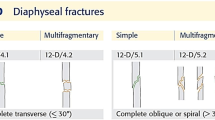Abstract
Open femural shaft fractures are a rare event that occurs in orthopedic surgery. They are mostly related to high-energy trauma. The authors analysed various treatments, which need to be customised to type of exposure and to the patient’s general clinical condition.
Similar content being viewed by others
Bibliografia
Enninghorst N, McDougall D, Evans JA et al. (2013) Population-based epidemiology of femur shaft fractures. J Traum Acute Care Surg 74(6):1516–1520
Pape HC, Giannoudis P, Kretek C (2002) The timing of fracture treatment in polytrauma patients: relevance of damage control orthopedic surgery. Am J Surg 183:622–629
Giannoudis PV (2003) Surgical priorities in damage control in polytrauma. J Bone Jt Surg, Br 85(4):478–483
Bone LB, Johnson KD, Weigelt J, Scheinberg R (1989) Early versus delayed stabilization of femoral fractures. A prospective randomized study. J Bone Jt Surg, Am 71:336–340
Canadian Orthopedic Trauma Society (2006) Reamed versus unreamed intra-medullary nailing of the femur: comparison of the rate of ARDS in multiple injured patients. J Orthop Trauma 20:384–387
O’Toole RV, O’Brien M, Scalea TM et al. (2009) Resuscitation before stabilization of femoral fractures limits acute respiratory distress syndrome in patients with multiple traumatic injures despite low use of damage control orthopedics. J Trauma 67:101–121
Rixen D, Grass G, Sauaerland S et al. (2005) Evaluation of criteria for temporary external fixation in risk-adapted damage control orthopedic surgery of femur shaft fractures in multiple trauma patients. J Trauma 59:1375–1395
Pape HC, Rixen D, Morley J et al. (2007) Impact of the method of initial stabilization for femoral shaft fractures in patients with multiple injuries at risk for complications (borderline patients). Ann Surg 246:491–499
Nahm NJ, Vallier HA (2012) Timing of definitive treatment of femoral shaft fractures in patients with multiple injuries: a systemic review of randomized and nonrandomized trials. J Trauma Acute Care Surg 73:1046–1063
Kobbe P, Micansky F, Licthe P et al. (2013) Increased morbidity and mortality after bilateral femoral shaft fractures: myth or reality in the era of damage control? Injury 44:221–225
Schreiber MV, Tarkin IS, Hildebrand F et al. (2011) The timing of definitive fixation for major fractures in polytrauma—a matched pair comparison between a US and European Level I trauma centres: analysis of current fracture management practice in polytrauma. Injury 42:650–654
Morshed S, Miclau T, Bembom O et al. (2009) Delayed internal fixation of femoral shaft fracture reduces mortality among patients with multisystem trauma. J Bone Jt Surg, Am 91:3–13
Nahm NJ, Como JJ, Wilber JH, Vallier HA (2011) Early appropriate case: definitive stabilization of femoral fractures within 24 hours of injury is safe most patients with multiple injuries. J Trauma 71:175–185
Rudloff MI, Smith WR (2009) Intramedullary nailing of the femur: current concepts concerning reaming. Orthop Trauma 23:512–517
Broos P, Reynders P (1998) The unreamed AO femoral intramedullary nail, advantages and disadvantages of a new modular interlocking system. A prospective study of 67 cases. Acta Orthop Belg 64(3):284–290
Brumback RJ, Virkus WW (2000) Intramedullary nailing of the femur: reamed versus nonreamed. J Am Acad Orthop Surg 8:83–90
Boriani S, Pascarella R (2006) L’inchiodamento endomidollare nelle fratture esposte del femore. GIOT Suppl 1:S82–S84
Liao JC, Hsieh P-H, Chuang T-Y et al. (2003) Mini-open intramedullary nailing of acute femoral shaft fracture: reduction through a small incision without a fracture table. Chang Gung Med J 26:660–668
Author information
Authors and Affiliations
Corresponding author
Ethics declarations
Conflitto di interesse
Gli autori Achille Contini, Carlo de Roberto, Claudio Latte, Alfredo Bottiglieri, Costantino Corvino e Luigi Romano dichiarano di non avere alcun conflitto di interesse.
Consenso informato e conformità agli standard etici
Tutte le procedure descritte nello studio e che hanno coinvolto esseri umani sono state attuate in conformità alle norme etiche stabilite dalla dichiarazione di Helsinki del 1975 e successive modifiche. Il consenso informato è stato ottenuto da tutti i pazienti inclusi nello studio.
Human and Animal Rights
L’articolo non contiene alcuno studio eseguito su esseri umani e su animali da parte degli autori.
Rights and permissions
About this article
Cite this article
Contini, A., de Roberto, C., Latte, C. et al. Fratture esposte diafisarie di femore. LO SCALPELLO 30, 38–40 (2016). https://doi.org/10.1007/s11639-016-0147-y
Published:
Issue Date:
DOI: https://doi.org/10.1007/s11639-016-0147-y




